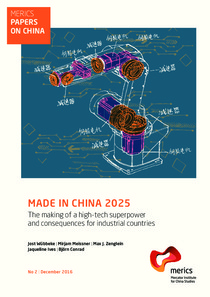Made in China 2025: the making of a high-tech superpower and consequences for industrial countries
"This report analyses China’s ambitious plan to build one of the world’s most advanced and competitive economies with the help of innovative manufacturing technologies (“smart manufacturing”). China’s industrial masterplan “Made in China 2025” aims to turn the country into a “manufacturing supe...
| Main Authors: | , , , , |
|---|---|
| Institution: | ETUI-European Trade Union Institute |
| Format: | TEXT |
| Language: | English |
| Published: |
Berlin
2016
Merics |
| Subjects: | |
| Online Access: | https://www.labourline.org/KENTIKA-19399538124911177109-Made-in-China-2025-the-making-.htm |
| Summary: | "This report analyses China’s ambitious plan to build one of the world’s most advanced and competitive economies with the help of innovative manufacturing technologies (“smart manufacturing”). China’s industrial masterplan “Made in China 2025” aims to turn the country into a “manufacturing superpower” over the coming decades. This industrial policy will challenge the economic primacy of the current leading economies and international corporations. The strategy targets virtually all high-tech industries that strongly contribute to economic growth in advanced economies: automotive, aviation, machinery, robotics, high-tech maritime and railway equipment, energy-saving vehicles, medical devices and information technology to name only a few. Countries in which these high-tech industries contribute a large share of economic growth are most vulnerable to China’s plans (see graphic below). This report examines the repercussions of Made in China 2025 focusing specifically on smart manufacturing. The promotion and dissemination of smart manufacturing technology is the centrepiece of the strategy, borrowing from the German concept of Industry 4.0 and the Industrial Internet formulated in the United States. By energetically upgrading the mostly backward industrial processes of China’s manufacturing sector, the Chinese government hopes to enhance the competitiveness of its enterprises on domestic markets and to propel their global expansion. " |
|---|---|
| Physical Description: | 73 p. Digital |

